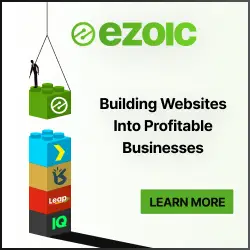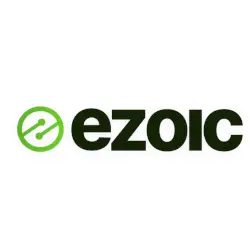Maximizing Ad Revenue Button: How Ezoic's Latest Features Optimize Ad Placement, Size, Type, and Density
- Ad placement:
- User behavior:
- Content relevance:
- Ad format:
- Ad density:
- Ad size:
- 300 x 250
- 728 x 90
- 160 x 600
- 970 x 250
- Ad types:
- Display Ads
- Native Ads
- Video Ads
- Pop-up Ads
- Ad density:
- Website content:
- Ad placement:
- User behavior:
- Ad size and type:
- Should you use the Maximize your site's revenue button ?
- Frequently Asked Questions
Ezoic is a platform that provides website owners with tools to optimize their ad revenue. One of its latest features is the maximize your site's revenue button. When clicked, this button activates all of Ezoic's recommended settings for optimizing ad revenue on your website.
These settings include things like:
Ad placement:
Ezoic uses machine learning to determine the best positions on your website for displaying ads. By enabling this setting, Ezoic will automatically place ads in the optimal locations.
Ad placement is the process of determining where on a website's pages to display advertisements in order to maximize revenue and user engagement. Ad placement is a critical factor in the success of online advertising, as it can impact the visibility and click-through rates of ads.
There are several factors to consider when determining the optimal ad placement for a website. These include:
User behavior:
The placement of ads should be based on where users are most likely to look on a website. For example, ads placed above the fold (the top portion of a webpage that is visible without scrolling) tend to have higher visibility and click-through rates than ads placed below the fold.
Content relevance:
Ads should be placed in locations that are relevant to the content on the page. For example, if a website has an article about gardening, ads for gardening tools or plants would be more relevant than ads for unrelated products or services.
Ad format:
The format of the ad can impact where it should be placed. For example, display ads are typically placed on the sides of a webpage, while in-line ads (ads that appear within the content of a page) may be more effective when placed within relevant content.
Ad density:
The number of ads displayed on a page can impact where they should be placed. Too many ads can be overwhelming for users, while too few may not generate enough revenue. Finding the right balance is key.
Ezoic uses machine learning to analyze user behavior and other factors to determine the optimal placement for ads on a website. By enabling Ezoic's ad placement settings, website owners can automatically display ads in the most effective locations for their audience, potentially increasing revenue and engagement.
Ad size:
Ezoic can also determine the best ad sizes for your website. By enabling this setting, Ezoic will automatically adjust the size of your ads to maximize revenue.
Ad size refers to the physical dimensions of an advertisement that is displayed on a website. It is an important factor in determining how well an ad will perform, as it can impact its visibility, engagement, and overall effectiveness.
The size of an ad is typically measured in pixels and can vary depending on the type of ad and the placement location. Different ad sizes have different benefits and drawbacks, and choosing the right size can impact the success of a website's advertising strategy.
Here are some common ad sizes and their benefits:
300 x 250
300 x 250 - also known as a medium rectangle, this ad size is one of the most popular and effective sizes for display ads. It can be placed in a variety of locations on a website and is effective at capturing users' attention without being too intrusive.
728 x 90
728 x 90 - also known as a leaderboard, this ad size is typically placed at the top of a webpage and is effective at capturing users' attention as they first enter a page. However, its larger size can also be seen as more intrusive by some users.
160 x 600
160 x 600 - also known as a skyscraper, this ad size is typically placed along the side of a webpage and is effective at capturing users' attention as they scroll down a page. However, its vertical orientation can make it less flexible for certain ad placements.
970 x 250
970 x 250 - also known as a billboard, this ad size is one of the largest available and is typically placed at the top or bottom of a webpage. Its larger size can make it more noticeable to users, but can also be seen as more intrusive.
Ezoic uses machine learning to analyze user behavior and other factors to determine the optimal ad size for a website's audience. By enabling Ezoic's ad size settings, website owners can automatically adjust the size of their ads to optimize visibility and engagement, potentially increasing revenue and user satisfaction.
Ad types:
Optimize your site
Increase ad revenue 50-250% with Ezoic. A Google Certified Publishing Partner.
Maximize revenue
Ezoic can recommend the best types of ads for your website, including display ads, native ads, and more. By enabling this setting, Ezoic will automatically display the most effective types of ads for your audience.
Ad types refer to the different formats and styles of advertisements that can be displayed on a website. Choosing the right ad type can impact how well the ad performs, how it resonates with users, and how it contributes to a website's revenue.
Here are some common ad types and their benefits:
Display Ads
These are traditional banner ads that are typically placed in prominent locations on a webpage. They can be either static or animated and can vary in size and shape. Display ads can be effective at capturing users' attention and driving clicks, but may also be seen as intrusive.
Native Ads
These are ads that are designed to look and feel like part of the website's content. They can be placed within articles or other content, and are often labeled as sponsored or recommended. Native ads can be effective at blending in with the website's content and engaging users without being intrusive.
Video Ads
These are ads that are displayed as video content. They can be pre-roll (shown before a video), mid-roll (shown during a video), or post-roll (shown after a video). Video ads can be effective at capturing users' attention and driving engagement, but may also be seen as disruptive if they are too long or frequent.
Pop-up Ads
These are ads that are displayed in a separate window or tab when a user clicks on a link or button on a webpage. Pop-up ads can be effective at grabbing users' attention, but are often seen as intrusive and can lead to a negative user experience.
Ezoic uses machine learning to analyze user behavior and other factors to determine the optimal ad types for a website's audience. By enabling Ezoic's ad type settings, website owners can automatically display the most effective types of ads for their audience, potentially increasing revenue and user engagement while maintaining a positive user experience.
Ad density:
Ezoic can determine the optimal number of ads to display on your website. By enabling this setting, Ezoic will automatically adjust the number of ads on your website to maximize revenue.
Ad density refers to the number of advertisements that are displayed on a webpage. It is an important factor in determining how well a website's advertising strategy will perform, as it can impact user engagement, revenue, and overall user experience.
There are different factors to consider when determining the optimal ad density for a website. Here are some common considerations:
Website content:
The content of a website can impact the optimal ad density. For example, websites with long-form content may be able to accommodate more ads without overwhelming users, while websites with shorter content may require fewer ads to maintain a positive user experience.
Ad placement:
The placement of ads can impact how many ads can be displayed without being too intrusive. For example, ads placed above the fold tend to have higher visibility and click-through rates than ads placed below the fold, which may allow for more ads to be displayed without overwhelming users.
User behavior:
User behavior can impact how many ads can be displayed without negatively impacting engagement. For example, users who are more likely to click on ads may be able to tolerate more ads than users who are less likely to engage with ads.
Ad size and type:
The size and type of ads can also impact ad density. For example, larger ads may require more space on a webpage, while smaller ads may allow for more ads to be displayed without being too overwhelming.
Ezoic uses machine learning to analyze user behavior and other factors to determine the optimal ad density for a website's audience. By enabling Ezoic's ad density settings, website owners can automatically adjust the number of ads on their website to optimize revenue and user experience, potentially increasing revenue while maintaining a positive user experience.
Should you use the Maximize your site's revenue button ?
By clicking the maximize your site's revenue button, website owners can take advantage of all of these settings at once, without having to manually configure each one. This can save time and effort while also potentially increasing ad revenue for the website.
Frequently Asked Questions
- How do Ezoic's latest features for optimizing ad placement, size, type, and density contribute to a more sustainable online advertising model?
- Ezoic's latest features contribute to a more sustainable online advertising model by ensuring ads are displayed in a way that maximizes efficiency and minimizes unnecessary energy use, thereby reducing the digital carbon footprint of websites.
- How does Ezoic's Maximizing Ad Revenue button optimize ad performance?
- Ezoic's Maximizing Ad Revenue button uses AI to adjust ad placement, size, type, and density automatically, ensuring optimal performance and maximizing revenue without manual intervention.

Yoann Bierling is a Web Publishing & Digital Consulting professional, making a global impact through expertise and innovation in technologies. Passionate about empowering individuals and organizations to thrive in the digital age, he is driven to deliver exceptional results and drive growth through educational content creation.
Optimize your site
Increase ad revenue 50-250% with Ezoic. A Google Certified Publishing Partner.
Maximize revenue


